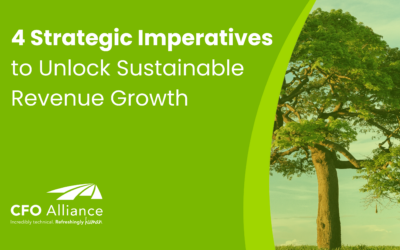4 Strategic Imperatives to Unlock Sustainable Revenue Growth
Creating long-term, sustainable revenue growth takes more than marketing campaigns and sales incentives. Revenue growth is a collaborative endeavor that begins in the C-suite and flows throughout the entire organization. To drive the bottom line results you’re looking for, strategy must align across finance, operations, sales, marketing, and the executive team.
A cohesive, successful revenue strategy starts with a strong relationship between the CEO and CFO. Working together, the CEO and CFO should ensure that all business activities are supporting revenue growth, that sales and marketing are aligned, and that business decisions yield the expected results.
Let’s look at four ways to achieve these goals.
Encourage Collaboration Among Leaders
Sales and marketing can no longer afford to operate independently in today’s increasingly connected world. Customer experiences include both sales and marketing processes, and purchasing patterns no longer follow a sequential pathway from marketing to sales. As a result, 70% of marketers say they no longer feel confident in their ability to sell effectively. To resolve this issue, companies will need to align sales and marketing processes, invest in technology that enables shared data, and integrate sales and marketing data across the customer journey.
That’s why, in addition to the CEO/CFO dream team, you should also prioritize collaboration among departmental leaders, including managers, directors, and supervisors. By building strong relationships across the organization, you can break down departmental silos and encourage cross-organizational integration.
Harness Data & Measure Outcomes
Data-based decision-making is critical for long-term revenue growth. Quality, real-time data empowers you to monitor and predict market trends, identify customer behavior, keep a close eye on revenue and cash flow, and make precise course corrections before unexpected changes impact your bottom line. As markets remain uncertain for the near future, data will continue to hold the key to financial stability and growth. Here are three things to watch:
- Monitor Financial KPIs – Tracking the right financial data points gives you critical information that will keep your business viable and drive improved performance. Which metrics should you track? Start with key performance indicators like the ones we wrote about here. In addition, keep a close eye on your balance sheet, cash flow, and valuation metrics. All of these numbers will offer insight into the health and profitability of your business.
- Monitor Related Business KPIs – Since revenue growth is directly related to sales and marketing outcomes, you’ll want to track KPIs in these areas of the business as well. For example, leads per month or per channel, sales team response times, customer acquisition costs, traffic to lead ratios, landing page conversions, and social media metrics are all critical data points you can use to evaluate whether your sales and marketing processes are generating expected results.
- Compare Growth with Industry Benchmarks – Economic conditions, customer expectations, supply chain challenges, and labor shortages can all impact growth expectations within a particular industry. If your industry is experiencing setbacks, growth opportunities will be affected. That doesn’t mean growth is impossible; it just means you may need to rethink your strategy and pivot.
Empower Your Team
Marketing isn’t the only department responsible for growth. As you design your revenue growth strategy, consider how different teams work together and empower them to collaborate effectively. For example:
- Encourage Creative Problem Solving – Numbers are critical, but they need to be balanced with creative problem solving to produce positive results. According to Deloitte, high-growth brands are more likely to foster creative ideas, encourage risk-taking, and promote creative collaboration among team members. The goal in all these endeavors is to support analysis with creative thinking for better outcomes.
- Provide Adequate Resources – Give your teams the resources they need to do their jobs effectively. Those resources may include additional team members, better numbers, improved technology, or additional training. In the finance department, this might mean automating repetitive processes so teams are free to focus on strategic work, create better forecasts, and streamline operations.
- Build a Culture of Recognition and Growth – Growth cultures emphasize growth mindset in their teams, invest in holistic development of team members, celebrate successes with intentional recognition, and provide coaching-style management to help team members capitalize on their strengths.
Invest in Systems for Business Resilience
We’ve written extensively about technology transformation and systems elsewhere (including tech skills, financial tech transformation, and transformation strategy). In addition to those recommendations, we’ll leave you with just a few thoughts:
- Ensure Good Hygiene in Your Systems in General – Tech hygiene includes following generally accepted best practices for ensuring reliability and accuracy across your systems. This includes standardizing data, breaking down data silos, following safe security practices, regularly updating digital assets, and conducting regular data cleanses.
- Use AI and ChatGPT to Your Advantage – As AI-empowered tools become more sophisticated, they will also offer new opportunities to improve speed, efficiency, and accuracy. ChatGPT, for example, can already assist with numerous operations including information summaries, customer service asset creation, analysis of customer feedback, intelligent search, and much more. Consider investing in technology innovation and automation so your employees can focus on creating value rather than performing repetitive, tedious tasks.
- Eliminate Single Points of Failure – Single points of failure pose significant risk for your business. If they fail the entire system falls apart. Look for them in areas like finance, lead generation, customer markets, institutional knowledge, and talent.
Ignite Your Growth Potential
To create sustainable revenue growth, founders must embrace a comprehensive approach that integrates strategy, collaboration, data-driven decision-making, team empowerment, and system resilience. Reaching that potential requires flexible, scalable financial strategies that can serve you at every stage of growth.
That’s where CFO Alliance can help. We serve as your financial partner, guide, and biggest cheerleader, coming alongside you to roll up our sleeves and get things done. When you have questions, we have answers. Contact us today to see how we can help you make your vision a reality.
4 Strategic Imperatives to Unlock Sustainable Revenue Growth
4 Strategic Imperatives to Unlock Sustainable Revenue GrowthCreating long-term, sustainable revenue growth takes more...
Future-Proof Your Workforce with a Modern Talent Agenda
Future-Proof Your Workforce with a Modern Talent AgendaWhat does the future of talent look like? It’s a fair question,...
The Talent Behind the Tech: How Skills-Based Hiring Supports Technology Innovation
The Talent Behind the Tech: How Skills-Based Hiring Supports Technology InnovationStaying relevant with technology in...




